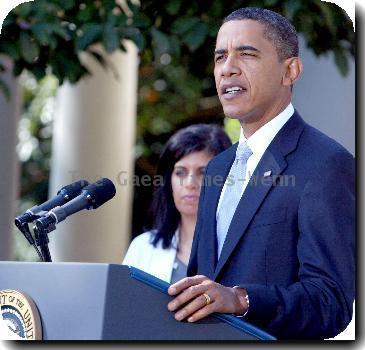Expert: Surface area of Gulf oil spill has tripled; rough seas again thwart containment
By Holbrook Mohr, APSaturday, May 1, 2010
Expert: Surface area of Gulf oil spill has tripled
VENICE, La. — The surface area of a catastrophic Gulf of Mexico oil spill quickly tripled in size amid growing fears among experts that the slick could become vastly more devastating than it seemed just two days ago.
The newly named federal point man for the oil spill said it was impossible to pinpoint precisely how much oil is leaking from a ruptured underwater well.
“And, in fact, any exact estimation of what’s flowing out of those pipes down there is probably impossible at this time due to the depth of the water and our ability to try and assess that from remotely operated vehicles and video,” Coast Guard Commandant Adm. Thad Allen said during a conference call Saturday.
The Coast Guard has given a rough estimate that 200,000 gallons of oil are spewing out each day — which would mean 1.6 million gallons of oil have spilled since the April 20 explosion that killed 11 workers. The environmental mess could eclipse the Exxon Valdez disaster, when an oil tanker spilled 11 million gallons off Alaska’s shores in 1989.
Although estimates of the rate of the leak are inexact, Allen said the most pressing priority is capping the undersea leak at its source because it could otherwise spew oil for 45 to 90 days. He said it has not been determined how much oil is below the surface.
President Barack Obama has planned a Sunday trip to the Gulf Coast for an update on containment efforts.
Documents also have emerged showing BP PLC downplayed the possibility of a catastrophic accident at the offshore rig that exploded. BP operated the rig, which was owned by Transocean Ltd.
How far the spill will reach is unknown, but the sheen already has reached into precious shoreline habitat and remains unstopped, raising fears that the ruptured well could be pouring more oil into the gulf than estimated.
The slick nearly tripled in just a day or so, growing from a spill the size of Rhode Island to something closer to the size of Puerto Rico, according to images collected from mostly European satellites and analyzed by the University of Miami.
On Thursday, the size of the slick was about 1,150 square miles, but by Friday’s end it was in the range of 3,850 square miles, said Hans Graber, executive director of the university’s Center for Southeastern Tropical Advanced Remote Sensing. That suggests the oil has started spilling from the well more quickly, Graber said.
“The spill and the spreading is getting so much faster and expanding much quicker than they estimated,” Graber told The Associated Press on Saturday.
Louisiana State University professor Ed Overton, who heads a federal chemical hazard assessment team for oil spills, cautioned that satellites can’t measure the thickness of the sheen, which makes it difficult to judge how much oil is on the water.
Another issue is that the oil slicks are not one giant uniform spill the size of an island. Instead, they are “little globs of oil in an area of big water,” Overton said.
Still, experts cautioned that if the spill continues growing unchecked, sea currents could suck the sheen down past the Florida Keys and then up the Eastern Seaboard.
The Florida Keys are home to the only living coral barrier reef in North America, and the third largest coral barrier reef in the world. About 84 percent of the nation’s coral reefs are located in Florida, where hundreds of marine species live, breed and spawn.
“If it gets into the Keys, that would be devastating,” said Duke University biologist Larry Crowder.
Ian R. MacDonald, an oceanography professor at Florida State University, said his examination of Coast Guard charts and satellite images indicated that 8 million to 9 million gallons had already spilled by April 28.
Alabama’s governor said his state was preparing for a worst-case scenario of 150,000 barrels, or more than 6 million gallons per day. At that rate the spill would amount to a Valdez-sized spill every two days, and the situation could last for months.
“I hope they can cap this and we talk about ‘remember back when,’” Gov. Bob Riley said late Friday, “but we are taking that worst-case and building barriers against it.”
The spill — a slick more than 130 miles long and 70 miles wide — threatens hundreds of species of wildlife, including birds, dolphins, and the fish, shrimp, oysters and crabs that make the Gulf Coast one of the nation’s most abundant sources of seafood.
BP suggested in a 2009 exploration plan and environmental impact analysis for the well that an accident leading to a giant crude oil spill — and serious damage to beaches, fish and mammals — was unlikely, or virtually impossible.
The Coast Guard said Saturday it had shut down two offshore platforms and evacuated one of them near the spill as a safety precaution.
A sheen of oil from the edges of the slick was washing up at Venice, La., and other extreme southeastern portions of Louisiana. Animal rescue operations ramped up as crews found the first oiled bird offshore.
Several miles out, the normally blue-green gulf waters were dotted with sticky, pea- to quarter-sized brown beads the consistency of tar. High seas were forecast through Sunday and could push oil deep into the inlets, ponds, creeks and lakes that line the boot of southeastern Louisiana. With the wind blowing from the south, the mess could reach the Mississippi, Alabama and Florida coasts by Monday.
Amid increased fingerpointing, the government desperately cast about for new ideas for dealing with the growing environmental crisis. Obama halted any new offshore drilling projects unless rigs have new safeguards to prevent another disaster.
Lt. James McKnight, public information officer for the Coast Guard in Mobile, Ala., said hundreds of boats are laying thousands of feet of boom along the shore of that state and Florida.
He also said a team of experts from the National Oceanic and Atmospheric Administration, BP employees, federal workers and outside scientists were working at the command center in Mobile to help come up with new ideas to contain the spill.
“It’s almost like a brain trust down there. They are trying to come up with any new ideas,” McKnight said.
They are closely watching the winds and currents to see where the massive slick is headed. The NOAA scientists there have said the oil so far is mostly at the surface, meaning it shouldn’t make its way into the currents just yet.
Officials have said stemming the flow of oil is their top priority, but the seas have been too rough and the winds too strong to burn off the oil, suck it up effectively with skimmer vessels, or hold it in check with the miles of orange and yellow inflatable booms strung along the coast.
The floating barriers broke loose in the choppy water, and waves sent oily water lapping over them.
BP and federal authorities also released a chemical dispersant overnight at the site of the leak, nearly a mile underwater, and they were evaluating the effort Saturday.
Many of the oil-cleaning boats remained tied to the docks Saturday in Venice, partly because of the weather.
The weather also was keeping skimmers and other larger vessels stuck in harbor, said Coast Guard Petty Officer 1st Class David Mosley, a spokesman for a command center in Robert, La.
“Waves are going anywhere from 5 feet to 8 feet high and getting bigger,” he said. “It definitely makes it more difficult.”
Associated Press writers Seth Borenstein, Melissa Nelson, Michael Kunzelman, Chris Kahn, Allen G. Breed, Vicki Smith, Janet McConnaughey, Alan Sayre, Tamara Lush and Brian Skoloff contributed to this report.
Tags: Accidents, Alabama, Animals, Barack Obama, Coastlines And Beaches, Coral Reefs, Corporate Crime, Environmental Concerns, Florida, Gulf, Louisiana, Marine Animals, Mobile, North America, Oil spill, United States, Venice, Wildlife





